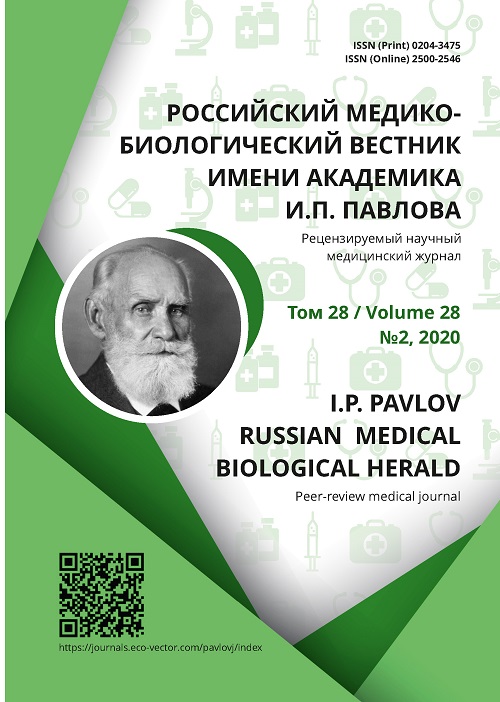稳定缺血性心脏病和冠状动脉旁路移植术患者心理状态指标的动态变化
- 作者: Solodukhin A.V.1, Trubnikova O.A.1, Barbarash O.L.1
-
隶属关系:
- Research Institute for Complex Problems of Cardiovascular Diseases
- 期: 卷 28, 编号 2 (2020)
- 页面: 164-170
- 栏目: Original study
- ##submission.dateSubmitted##: 01.07.2020
- ##submission.datePublished##: 03.07.2020
- URL: https://journals.eco-vector.com/pavlovj/article/view/34906
- DOI: https://doi.org/10.23888/PAVLOVJ2020282164-170
- ID: 34906
如何引用文章
详细
目的:冠状动脉旁路移植术(CABG)对缺血性心脏病(CHD)患者心理状态指标的动态评估和分析。
材料与方法:对58例从40到74岁稳定型缺血性心脏病的男性患者进行冠状动脉旁路移植前后心理状态指标,即疾疾病的内部图像、应对策略和生活取向的研究。患者入院后2-3天,冠状动脉旁路移植后7-8天由临床心理学家对各项指标进行评估。临床和心理诊断采用TOBOL问卷对疾病的态度(L.I.Wasserman)、《生活取向》(D.A. Leontiev)、《应对行为策略》(R. Lazarus,S. Folkman, T. A. Kryukova的改编版)。采用Statistica 10.0计算机软件进行统计分析。
结果:缺血性心脏病患者冠脉搭桥术后,采用TOBOL问卷、应激克服行为评估中的《积极重估》应对策略,以及《目的》在评估神经质根据《生活取向》测试中的量表水平都已确定指标的显著下降。
结论:研究结果表明,缺血性心脏病患者在冠状动脉旁路移植后,由于行为障碍和难以制定进一步的康复目标,对疾病的适应程度有所下降。为了增加术后适应,心理矫正影响的《目标》可能是《积极重估》应对策略及目标设定有助于患者在冠状动脉旁路移植后阶段制定目标。
全文:
到目前为止,缺血性心脏病(CHD)在俄罗斯工龄人群的致残原因中占据主导地位[1]。外科治疗是治疗缺血性心脏病最现代、最有效的方法。对缺血性心脏病患者的最高科技的心脏外科治疗方法之一被认为是冠状动脉旁路移植术(CABG)。这种类型的手术被认为是最有希望提高严重或快速进展的缺血性心脏病患者的生活质量[2]。
在52个国家进行的INTERHEART研究证实,心理情绪障碍与吸烟、高血压和糖尿病一起,在心脏病的进展中发挥重要作用[3]。缺血性心脏病发展的风险和不良后果的研究让确定了许多心理因素,其阻碍冠状动脉旁路移植后的全面康复:疾病的内部图像(IPD)的不适应变异、精神情绪障碍、无效的应对策略等[4]。
为了预防术后危险因素,进一步发展缺血性心脏病患者的心理护理方法,针对冠状动脉旁路移植,有必要对这类患者的心理参数结构和动态进行全面研究。
目的是评估针对冠状动脉旁路移植的缺血性心脏病患者心理状态指标的动态变化。
材料与方法
从2018年到2019年,对58例男性40到74岁稳定缺血性心脏病患者进行心理检查,其计划在人工血液循环条件下进行冠状动脉旁路移植术在Scientific Research Institute of Complex Problems of Cardiovascular Diseases联邦国家预算科学研究所。
纳入标准:男性,其计划进行冠状动脉旁路移植,并自愿知情同意参与研究的患者。
排除标准:不稳定心绞痛的存在;左心室射血分数降低(低于40%);严重心律失常和传导障碍;最近(少于28天)发生心肌梗死;严重的躯体疾病妨碍了康复活动;拒绝参加研究的病人。
这项研究是根据良好临床实践的标准(Good Clinical Practice)和世界协会赫尔辛基宣言《人体医学研究的伦理准则》进行的。所有参与者都签署了知情的自愿同意书。这项工作得到了俄罗斯科学院西伯利亚分院基础科学研究综合计划的支持。该研究方案得到了当地Scientific Research Institute of Complex Problems of Cardiovascular Diseases联邦国家预算科学研究所伦理委员会的批准。
临床和遗忘特征见表1。
表1。冠状动脉旁路移植前患者的临床病史特征(n=58)
指标 | 结果 |
平均年龄,岁,Me [Q25;Q75] | 60 (54; 65) |
缺血性心脏病时间,年数,Me [Q25; Q75] | 1 (1; 4) |
高血压时间,年数,Me [Q25; Q75] | 6 (3; 9) |
高血压,n(%) | 54 (93) |
颈动脉狭窄,n(%) | 19 (33) |
左心室射血分数,Me [Q25; Q75] | 60.5 (55; 64) |
病史心脏病发作,n(%) | 35 (61) |
身体质量指数,kg/m2,Me [Q25;Q75] | 28 (25; 31) |
总胆固醇,mmol/L,Me [Q25; Q75] | 3.9 (3.4; 4.2) |
临床和心理诊断对缺血性心脏病患者采用问卷调查由临床心理学家在患者入院后2-3天、冠状动脉旁路移植后7-8天进行。评估疾病的内部图像诊断包括TOBOL问卷对疾病的态度(L.I. Wasserman ),使用《生活取向》测试的个体的神经质水平(D.A. Leontiev),并压力克服或应对行为使用《应对行为策略》(R. Lazarus,S. Folkman, T. A. Kryukova的改编版)。
使用Statistica 10.0 计算机软件(Stat Soft Inc.,美国)进行统计分析。临床和心理参数的动态评估采用T-Wilcoxon标准。临床病史和心理指标以中位数和第25和第75百分位数的形式呈现(Me[Q25;Q75])。
结果与讨论
疾病的内部图像指标动态研究显示了冠状动脉旁路移植后患者的焦虑画面水平明显下降(表2)。
表2。针对冠状动脉旁路移植缺血性心脏病患者的疾病的内部图像指标严重程度的动态变化(n=58)
指标 | 疾病的内部图像,分数,Me [Q25; Q75] | p | |
冠状动脉旁路移植前 | 冠状动脉旁路移植7-10天后 | ||
和谐的 | 33 (26; 42) | 31 (25; 40) | 0.1 |
精力旺盛的 | 29 (26;40) | 29 (19;40) | 0.2 |
疾病失认症 | 24 (16;32) | 20 (13;30) | 0.2 |
敏感的 | 12 (8; 17) | 15 (8; 21) | 0.7 |
疑病的 | 7 (4;11) | 7 (4;14) | 0.6 |
以自我为中心的 | 5 (4;8) | 5 (5;9) | 0.1 |
焦急的 | 3 (0;8) | 0 (0;7) | 0.03 |
神经衰弱的 | 3 (0;7) | 4 (0;11) | 0.1 |
妄想症 | 2 (0;4) | 2 (0;6) | 0.9 |
忧郁的 | 0 (0;4) | 0 (0;4) | 0.2 |
焦虑不安 | 0 (0;3) | 0 (0;4) | 0.2 |
无情的 | 0 (0;3) | 0 (0;6) | 0.9 |
在分析压力克服行为参数的动态时,发现《积极重估》的应对策略水平有显著下降(表3)。
表3。针对冠状动脉旁路移植缺血性心脏病患者的应激克服行为严重程度的动态变化(n=58)
指标 | 应对策略,分数,Me [Q25; Q75] | p | |
冠状动脉旁路移植前 | 冠状动脉旁路移植7-10天后 | ||
疏远 | 51 (44;58) | 48 (41;58) | 0.2 |
寻找社会支持 | 50 (40;57) | 46 (40;51) | 0.5 |
积极重估 | 50 (41;55) | 45 (38;53) | 0.03 |
规划解决问题 | 48 (42;56) | 45 (42;51) | 0.4 |
逃跑-回避 | 46 (38;52) | 46 (35;54) | 0.07 |
对抗 | 46 (38;51) | 42 (4;11) | 0.3 |
自我控制 | 45 (39;54) | 42 (33;51) | 0.2 |
承担责任 | 44 (8; 17) | 47 (40; 55) | 0.3 |
缺血性心脏病患者生活取向动态研究显示冠状动脉旁路移植后《目标》指标明显下降(表4)。
表4。针对冠状动脉旁路移植缺血性心脏病患者的生活取向严重程度的动态变化(n=58)
指标 | 生活取向,分数,Me [Q25; Q75] | p | |
冠状动脉旁路移植前 | 冠状动脉旁路移植7-10天后 | ||
思考生命的意义 | 154 (135;169) | 154 (135;162) | 0.4 |
目的 | 38 (31;40) | 36 (31;38) | 0.02 |
过程 | 33 (31;40) | 35 (29;37) | 0.7 |
控制位点—生命 | 32 (28;37) | 33 (27;40) | 0.6 |
结果 | 28 (26;32) | 27 (23;32) | 0.1 |
控制位点—自我 | 23 (20;25) | 23(19;25) | 0.1 |
由此可知,手术前的准备工作对患者来说会成为一个强大的压力因素,并对其心理状态产生负面影响,以及今后的治疗过程和康复措施。在这方面,心理状态评估是全面康复计划的一个强制性组成部分。明确缺血性心脏病患者冠状动脉旁路移植前影响神经性障碍形成的因素,可以在术后及时纠正加重病情的心理情绪障碍。
通过对缺血性心脏病患者心理状态指标动态的研究,发现冠状动脉旁路移植后患者的疾病的内部图像、应对行为和生活取向等参数发生了变化。
疾病的内部图像是决定患者术后心理状态的重要因素之一[5]。众所周知,疾病的内部图像的高值不良焦虑-抑郁变异导致更频繁和不合理的医疗治疗,以及医疗预约的不充分表现[6]。在研究缺血性心脏病患者冠状动脉旁路移植后疾病的内部图像参数时,记录的疾病报警图像值明显下降,说明其与手术预期有直接关系。因此,在不提供额外心理帮助的情况下,术后焦虑疾病的内部图像的参数可独立改变。
在研缺血性心脏病患者的行为特征,特别是克服压力行为时,记录到《积极重估》指标减少。本研究结果证实了《积极重估》对减少心肌梗死患者消极体验的积极作用。由于使用这种应对策略的倾向较低,患有心肌梗死的患者可能会增加负面情绪,并对疾病和可能出现的并发症的过程无动于衷,从而对进一步的恢复预后产生负面影响[7]。由于对应对行为的评估,可见《积极重估》明显减少,这可能会增加冠状动脉旁路移植后心理适应不良的风险。因此,借助心理治疗方法在冠状动脉旁路移植前后形成积极的恢复情绪可以成为心理矫正影响的《靶点》之一。
在生活取向的研究中,进行冠状动脉旁路移植后《目标》指标也显著下降。众所周知,在这个范围内,高价值表明病人为未来设定目标的能力,这赋予生命意义、方向和时间前景。这些指标的减少表明难以制定长期目标,这可能导致抑郁状态的发展[8]。同时,抑郁是反复住院的一个重要预后因素,从2到6个月增加了冠状动脉旁路移植术后的死亡风险[9]。在此基础上,帮助形成术后进一步恢复的目标也是心理影响的一个重要《目标》。
结论
本研究结果使我们得出结论,缺血性心脏病患者在冠状动脉旁路移植后的适应水平由于行为障碍和难以制定进一步的康复目标而降低。为了提高缺血性心脏病患者冠状动脉旁路移植后的适应能力,心理控制影响的《目标》可能是一种《积极重估》的应对策略,有助于在术后阶段制定目标。
作者简介
Anton Solodukhin
Research Institute for Complex Problems of Cardiovascular Diseases
编辑信件的主要联系方式.
Email: mein11@mail.ru
ORCID iD: 0000-0001-8046-5470
SPIN 代码: 5487-7469
Researcher ID: H-7252-2016
Laboratory Assistant-Researcher of the Neurovascular Pathology Laboratory, Research Institute for Complex Issues of Cardiovascular Diseases
俄罗斯联邦, KemerovoOl`ga Trubnikova
Research Institute for Complex Problems of Cardiovascular Diseases
Email: mein11@mail.ru
ORCID iD: 0000-0001-8260-8033
SPIN 代码: 9174-6197
Researcher ID: N-5437-2015
MD, PhD, Head of the Neurovascular Pathology Laboratory, Research Institute for Complex Issues of Cardiovascular Diseases
俄罗斯联邦, KemerovoOl`ga Barbarash
Research Institute for Complex Problems of Cardiovascular Diseases
Email: mein11@mail.ru
ORCID iD: 0000-0002-4642-3610
SPIN 代码: 5373-7620
Researcher ID: A-4834-2017
MD, PhD, Professor, Correspondent Member of RAS, Director, Research Institute for Complex Issues of Cardiovascular Diseases
俄罗斯联邦, Kemerovo参考
- Pomeshkina SA, Kondrikova NV, Barbarash OL. Labour ability assessment of patients undergone coronary artery bypass grafting. Complex Issues of Cardiovascular Diseases. 2014;(1):26-30. (In Russ). doi: 10.17802/2306-1278-2014-1-26-30
- Shchetko VN. Features of surgical treatment of ischemic heart disease in patients with the expressed dysfunction left ventricular. Medical Herald of the South of Russia. 2018;9(1):99-104. (In Russ). doi: 10.21886/2219-8075-2018-9-1-99-104
- Yusuf, S., Hawken, S., Ôunpuu, S., et al. Effect of potentially modifiable risk factors associated with myocardial infarction in 52 countries (the INTERHEART study): case-control study. The Lancet. 2004;364 (9438):937-52. doi: 10.1016/s0140-6736 (04)17018-9
- Solodukhin AV, Trubnikova OA, Yanitsky MS, et al. Clinical-psychological characteristics of patients with CHD before preparation for coronary bypass depending on their psycho-emotional status. Lechaschi Vrach. 2017;(11):76-9. (In Russ).
- Polonskaya II, Sergeyeva VV. Medical and social aspects of rehabilitation for coronary heart disease after coronary artery bypass grafting. The Bulletin of Contemporary Clinical Medicine. 2018;11(6):68-73. (In Russ). doi: 10.20969/VSKM.2018.11(6).68-73
- Iakovleva MV, Lubinskaya CI, Demchenko EA. Internal Picture of the Disease as a Factor of Adherence to Treatment after Coronary Bypass Surgery. Bulletin of the South Ural State University. Ser. Psychology. 2015;8(2):59-70. (In Russ).
- Zubareva OA. Correlation between the coping behavior and types of attitude to the disease in patients with coronary heart disease. The Scientific Notes of the Pavlov University. 2014;21(4):32-5. (In Russ). doi: 10.24884/1607-4181-2014-21-4-32-35
- Vasilenko TD, Selin AV, Mangushev FY. Semantic aspects of corporal experience in a chronic somatic disease. Kursk Scientific and Practical Bulletin «Man and His Health». 2016;(2):116-21. (In Russ). doi: 10.21626/vestnik/2016-2/22
- Chugunova YV, Chumakova GA, Veselovskaya NG. Anxiety-depressive disorders and quality of life in patients with obesity, undergoing coronary artery bypass grafting: review. Mezhdunarodnyj Zhurnal Prikladnyh i Fundamental'nyh Issledovanij. 2015; (11)2: 235-38. Available at: https://applied-research.ru/ru/ article/view?id=7714. Accessed: 2020 February 21.
补充文件









